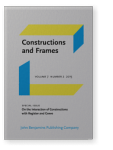Kerstin Fischer
List of John Benjamins publications for which Kerstin Fischer plays a role.
Journals
ISSN 1572-0373 | E-ISSN 1572-0381
Titles
What Influences Influence? How the Communicative Situation Influences Persuasion
Edited by Kerstin Fischer and Jaap Ham
Special issue of Interaction Studies 22:3 (2021) v, 225 pp.
Subjects Artificial Intelligence | Cognition and language | Evolution of language | Interaction Studies
Designing Speech for a Recipient: The roles of partner modeling, alignment and feedback in so-called 'simplified registers'
Kerstin Fischer
[Pragmatics & Beyond New Series, 270] 2016. x, 327 pp.
Subjects Communication Studies | Discourse studies | Pragmatics | Theoretical linguistics
On the Interaction of Constructions with Register and Genre
Edited by Kerstin Fischer and Kiki Nikiforidou
Special issue of Constructions and Frames 7:2 (2015) v, 243 pp.
Subjects Cognition and language | Functional linguistics | Syntax | Theoretical linguistics
2023 Chapter 7. Risk and responsibility in human-robot interaction: An interactional approach Risk Discourse and Responsibility, Ädel, Annelie and Jan-Ola Östman (eds.), pp. 172–189 | Chapter
In this chapter, I argue that interaction researchers have a large toolbox available to analyze the quality of current human-robot interactions, allowing us to identify possible risks concerning the introduction of social robots into our societies. I illustrate how interactional analyses can… read more
2021 What influences influence? How the communicative situation influences persuasion What Influences Influence? How the Communicative Situation Influences Persuasion, Fischer, Kerstin and Jaap Ham (eds.), pp. 291–302 | Introduction
This special issue addresses how aspects of the communicative situation influence how influential persuasive utterances (or other strategies of influence) are in their contexts of use. Specifically, we study the effects of interactional, speaker-, addressee- and channel-related factors and of… read more
2021 In the same boat: The influence of sharing the situational context on a speaker’s (a robot’s) persuasiveness What Influences Influence? How the Communicative Situation Influences Persuasion, Fischer, Kerstin and Jaap Ham (eds.), pp. 488–515 | Article
In this paper, we analyze what effects indicators of a shared situation have on a speaker’s persuasiveness by investigating how a robot’s advice is received when it indicates that it is sharing the situational context with its user. In our experiment, 80 participants interacted with a robot that… read more
2020 Integrative Social Robotics Hands-on Envisioning Social Robotics: Current challenges and new interdisciplinary methodologies, Hannibal, Glenda and Astrid Weiss (eds.), pp. 145–185 | Article
In this paper, we discuss the development of robot use cases in an elderly care facility in the context of exploring the method of Integrative Social Robotics (ISR) when used on top of a user-centered design approach. Integrative Social Robotics is a new proposal for how to generate responsible,… read more
2017 Comparing visualization techniques for learning second language prosody: First results Segmental, prosodic and fluency features in phonetic learner corpora, Trouvain, Jürgen, Frank Zimmerer, Bernd Möbius, Mária Gósy and Anne Bonneau (eds.), pp. 250–277 | Article
We tested the usability of prosody visualization techniques for second language (L2) learners. Eighteen Danish learners realized target sentences in German based on different visualization techniques. The sentence realizations were annotated by means of the phonological Kiel Intonation Model and… read more
2015 Situation in grammar or in frames? Evidence from the so-called baby talk register On the Interaction of Constructions with Register and Genre, Fischer, Kerstin and Kiki Nikiforidou (eds.), pp. 258–288 | Article
This paper addresses the conditions under which knowledge of situation-specific language use should be part of a construction grammatical representation and under which it should, rather, be part of a frame semantic representation. Using child-directed speech as an example, which has been suggested… read more
2015 On the interaction of constructions with register and genre On the Interaction of Constructions with Register and Genre, Fischer, Kerstin and Kiki Nikiforidou (eds.), pp. 137–147 | Article
2014 People do not interact with robots like they do with dogs Interaction Studies 15:2, pp. 201–204 | Article
2013 Beyond the sentence: Constructions, frames and spoken interaction Advances in Frame Semantics, Fried, Mirjam and Kiki Nikiforidou (eds.), pp. 183–205 | Article
Construction grammarians are still quite reluctant to extend their descriptions to units beyond the sentence. However, the theoretical premises of construction grammar and frame semantics are particularly suited to cover spoken interaction from a cognitive perspective. Furthermore, as construction… read more
2013 The addressee in the recipe: How Julia Child gets to join you in the kitchen Culinary Linguistics: The chef's special, Gerhardt, Cornelia, Maximiliane Frobenius and Susanne Ley (eds.), pp. 103–118 | Article
Texts may be adjusted to their target audiences to different degrees. Recipes are a highly conventionalized text-type, which leaves little room for variation; nevertheless, cookbooks are often tuned to particular audiences. The current study investigates how the addressee may be oriented to in… read more
2013 A radical construction grammar perspective on the modal particle-discourse particle distinction Discourse Markers and Modal Particles: Categorization and description, Degand, Liesbeth, Bert Cornillie and Paola Pietrandrea (eds.), pp. 47–88 | Chapter
2011 Mindful tutors: Linguistic choice and action demonstration in speech to infants and a simulated robot Interaction Studies 12:1, pp. 134–161 | Article
It has been proposed that the design of robots might benefit from interactions that are similar to caregiver–child interactions, which is tailored to children’s respective capacities to a high degree. However, so far little is known about how people adapt their tutoring behaviour to robots and… read more
2010 Beyond the sentence: Constructions, frames and spoken interaction Grammar and interaction: New directions in constructional research, pp. 185–207 | Article
Construction grammarians are still quite reluctant to extend their descriptions to units beyond the sentence. However, the theoretical premises of construction grammar and frame semantics are particularly suited to cover spoken interaction from a cognitive perspective. Furthermore, as construction… read more
2010 Editorial Pragmatics and Society 1:1, pp. 1–8 | Article
2003 Notes on analysing context Perspectives on Dialogue in the New Millennium, Kühnlein, Peter, Hannes Rieser and Henk Zeevat (eds.), pp. 193–214 | Article
















